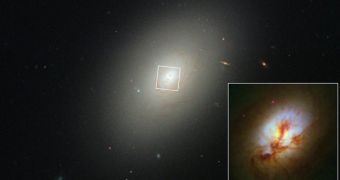For the most part, old galaxies tend to exhibit much lower rates of stellar formation that younger ones, and for obvious reasons. Yet it would appear that one particular galaxy identified by the Hubble Space Telescope didn't get the memo.
While conducting investigations of the elliptical galaxy NGC 4150, the observatory was able to identify elevated rates of stellar formation at the structure's core. The area, long since thought to be devoid of nurseries, is apparently pretty much active to this day.
Astronomers using the NASA telescope were able to identify numerous new blue stars, clumping together in stellar clusters near the location of the massive black hole that power the center of the galaxy.
Researchers additionally found massive streams and clouds of cosmic dust and hydrogen gas permeating the area. Stirring and mixing them together is probably what drives this frantic pace of stellar formation, experts in the field believe.
Most of the new stars found during the research were demonstrated to be a lot less than one billion years old, which hints at the fact that the galaxy, in spite of its old age, continues to produce new stars until very recently.
One possible explanation for why NGC 4150 continued to spawn new stars even after exhausting its own gas and dust reserves could be that the structure merged with dwarf galaxies along the way, cannibalizing on the dust these formations contained.
“Elliptical galaxies were thought to have made all of their stars billions of years ago. They had consumed all their gas to make new stars,” says University of Oxford astronomer Mark Crockett, the leader of the Hubble observations team.
“Now we are finding evidence of star birth in many elliptical galaxies, fueled mostly by cannibalizing smaller galaxies,” he says in a press release, quoted by Space.
Inside NGC 4150, Hubble's advanced Wide Field Camera 3 (WFC3) shows, the active stellar nursery spans an area of about 1,300 light-years across. For comparison, the entire Milky Way is some 100,000 light-years in diameter.
“These observations support the theory that galaxies built themselves up over billions of years by collisions with dwarf galaxies,” Crockett argues in the document.
“NGC 4150 is a dramatic example in our galactic backyard of a common occurrence in the early Universe,” he adds, saying that full details of the work will appear in an upcoming issue of the esteemed Astrophysical Journal.
“We are seeing this galaxy after the major starburst has occurred. The most massive stars are already gone. The youngest stars are between 50 million and 300 to 400 million years old,” says Joseph Silk.
“By comparison, most of the stars in the galaxy are around 10 billion years old,” adds the University of Oxford expert, who was also a member of the research team.

 14 DAY TRIAL //
14 DAY TRIAL //